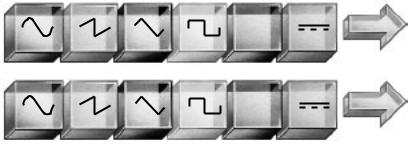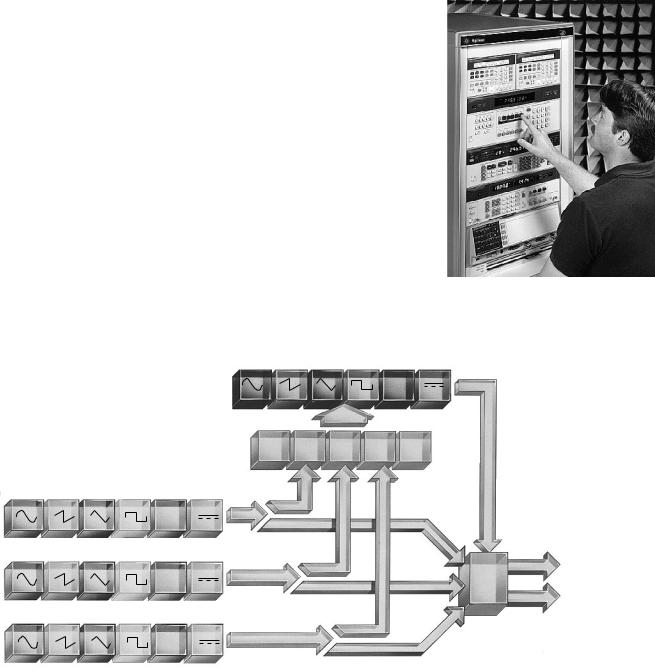Atec 8904A User Manual

Agilent 8904A
Multifunction Synthesizer dc to 600 kHz
Build complex waveforms from common signals

The Agilent 8904A
Multifunction Synthesizer . . .
The Agilent Technologies 8904A Multifunction Synthesizer uses the latest VLSIC technology to create complex signals from six fundamental waveforms. The standard 8904A digitally synthesizes precise sine, square, triangle, ramp, white noise, and dc waveforms and routes these signals to a single output. Option 001 adds three more identical internal synthesizers (channels) which can either modulate the first synthesizer or be summed to the output. Frequency, amplitude, waveform, phase, and destination can be independently set for each synthesizer. Available modulation types for channel A include AM, FM, F M, DSBSC, and pulse modulation. Option 002 adds a second 50 Ω output, providing a second separate signal for two channel applications. Option 003 adds fast hop and digital modulation capability to the 8904A. Option 005 allows multiple 8904As to be phase synchronized for applications which require the use of more than one 8904A. Option 006 changes output 1 of the 8904A from a 50 Ω floating output to a 600 Ω , high-power balanced output. With this option, the 8904A can deliver 10 volts rms into a 600 Ω load from 30 Hz to over 100 kHz. All this unique capability makes the 8904A a powerful tool for demanding applications like VOR, ILS, FM Stereo, and communications signaling.
. . . Begins with . . .
Function synthesizer
The Agilent 8904A Multifunction Synthesizer delivers synthesizer accuracy, along with six waveforms in a compact, economical package. Broad sinewave frequency coverage from 0.1 Hz to 600 kHz with 0.1 Hz resolution make the 8904A ideal for a number of lowfrequency applications. In addition to sinewave generation, the 8904A has five other standard functions: square, triangle, ramp, dc, and Gaussian white noise. Of these five, square, ramp, and triangle functions are available from 0.1 Hz to 50 kHz. All waveform values in the 8904A are DIGITALLY calculated in real time by Agilent’s Digital Waveform Synthesis IC. The use of this chip results in signals with very well-defined accuracy and exact repeatability. This means unprecedented performance at an unexpectedly low price. Compared with analog technologies, drift is eliminated, accuracy is improved, and the number of required adjustments is greatly reduced.
Modulation source
For demanding modulation requirements, where internal modulation sources of signal generators don’t measure up, use the Agilent 8904A Multifunction Synthesizer. With its digitally synthesized accuracy and resolution, the 8904A is an ideal, yet low cost, external modulation source for signal generators. Besides common sinewave modulation, the functions of the 8904A can be used to create more complex modulating signals. For example, use the 8904A to externally modulate a signal generator with the noise function while at the same time using internal modulation. Using this technique accurate degradation of the modulation signal-to- noise ratio can be achieved. To accommodate applications requiring remote operation for system use, the 8904A comes with GPIB as a standard feature.
2

. . . And . . .
Stimulus for audio circuits
The 8904A has many characteristics and features which make it well suited as a stimulus for audio circuits. The output of the 8904A is characterized by low spurious and harmonic content. Total harmonic distortion plus noise (including all spurs) can be as low as –78 dBc. With low distortion, the 8904A can be used to test many high performance audio devices. Another unique characteristic of the 8904A is its exceptional level flatness. From 0.1 Hz to 100 kHz, the 8904A offers ±0.009 dB level flatness relative to
1 kHz. This state-of-the-art performance is a real plus for high performance audio test applications. Ground loops can be one of the most difficult problems to correct in audio tests.
The 8904A is equipped with an electronically floating, 50 Ω output amplifier which makes overcoming ground loops easy.
Then add another . . .
Two outputs
Option 002 adds a second, identical synthesizer and floating output section to make the 8904A TWO synthesizers in one half-rack width instrument. Frequency, amplitude, waveform, and phase can be independently set for each of the two synthesizers. The flexibility provided by two sources is needed in a variety of applications. When simultaneous external modulation of a signal generator is required, the 8904A Option 002 provides an accurate, low-cost method of generating two independent modulating signals. Many two-input applications, such as differential amplifier testing, can benefit from the ability of the 8904A Option 002 to generate two independent test signals at the same time. Modern ATE systems designed to test complex systems or products require a number of sources to fully stimulate the device being tested. In these cases one or more 8904A Option 002 Multifunction Synthesizers can be used to provide multiple test signals. Two instruments provide four synthesizers and occupy only one 5.25-inch full rack space.
Phase offset
Although both synthesizers are independent, the relative phase between the two outputs can be precisely controlled. Either synthesizer can be varied in phase from 0 degrees to 359.9 degrees with a resolution of 0.1 degree. Direct digital synthesis ensures accurate, repeatable phase differentials. Phase accuracy between outputs is specified to be better than ±0.1 degree or 30 ns (whichever is greater) up to 100 kHz. Testing phase detectors, servo systems, shaft encoders, sonar, and other phase-sensitive two-port devices is easy and accurate with the 8904A Option 002. One unique application of the 8904A’s phase capabilities is in driving balanced loads or lines. By operating the two synthesizers 180 degrees out of phase, the 8904A can function as a balanced source with much higher voltage output capability. In this configuration, the 8904A can deliver +23.8 dBm (12 volts rms) into a balanced 600 Ω load with a 100 Ω effective source impedance.
3

Then add two more . . . and sum . . . and modulate . . .
Complex signal generation
By adding three more internal synthesizers (two with Option 002) which can modulate or be summed with synthesizer A (channel A), Option 001 is the key to complex signal generation for the Agilent 8904A Multifunction Synthesizer. All four internal synthesizers can be set to generate different waveforms, frequencies, amplitudes, and phases at the same time. These signals can then be DIGITALLY summed before routing to the output. If Option 002 is present, channels may be routed to either of the two outputs. In addition
to summing, Option 001 allows channels B, C, and D to be used as modulation sources for channel A. The allowable modulation types for channel A are: AM, FM, fM, DSBSC (Double Sideband Suppressed Carrier), and pulse modulation. Channels B, C, and D can be used to generate up to three independent forms of modulation at the same time, or can be summed prior to channel A modulation. Using summation and modulation, the 8904A Option 001 can generate many complex waveforms.
With Option 002, two units provide four independent outputs in one full width rack space.
CHANNEL A
AM FM F M DSB Pulse
CHANNEL B
CHANNEL C
Output 1
S
Output 2
CHANNEL D
Option 001 adds three internal synthesizers (two in conjunction with Option 002) which can modulate or be summed with channel A.
4
